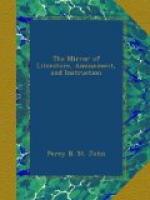The natives informed us that the fruit ripens early in autumn, and consists of bunches of apples, thinly beset with sharp thorns, each when broken producing one or two large kernels, about 2 in. in circumference, of the finest bright mahogany colour without, and white within; that the tree is deciduous, and just before its fall changes to the finest tints of red, yellow, orange, and brown. When divested of its luxuriant foliage, the buds of the next year appear like little spears, which through the winter are covered with a fine glutinous gum, evidently designed to protect the embryo shoots within, as an hybernaculum, from the severe frosts of the climate, and which glisten in the cold sunshine like diamonds. It has the strange property of performing the whole of its vigorous shoot, nearly a yard long, in the short space of three weeks, employing all the rest of the year in converting it into wood, adding to its strength, and varying its beauty. The wood when sawn is of the finest snowy whiteness. The tree is easily raised; indifferent as to soil, climate, or situation; removed with safety, of quick growth, thrives to a vast age and size; subject to no blight or disease; in the earliest spring bursting its immense buds into that vigour, exuberance, and beauty, which we have here feebly attempted to describe. The natives said it was originally brought from the east of Asia, but grows freely in any climate, and in their tongue its name is designated by a combination of three words, signifying separately, a noble animal, an elegant game, and a luscious kernel. Had Linnaeus seen this tree, he would have assuredly contemplated it with delightful ecstacy, and named it the Ae’sculus Hippocastanum.—Magazine of Natural History.
* * * * *
SPIRIT OF THE PUBLIC JOURNALS.
* * * * *
CIGAR-SMOKING.
The Surgeon-General of the Forces has recently made public his belief, that never, till within the last twenty years, did he see so many young men with pale faces and emaciated figures, and he attributes the existence of the evil to the use of Cigars. The unreflecting servility with which men adopt new and foreign practices, is fully exemplified in the present case; for it is notorious that the practice of cigar-smoking, the modern foppery from Regent-street to Cheapside and Cornhill, was an importation of the Peninsular War; the imitation having been begun by the Spaniards, whose models are what are usually called the savages of America. The dietetic mischief, and consequent paleness of complexion and emaciation of muscle, which are attributable to the use of cigars, belong, no doubt, to an injury inflicted, perhaps, in more ways than one upon the aids and organs of digestion; nor is that hypothesis at all inconsistent with what we hear from so many cigar-smokers, namely, that their




